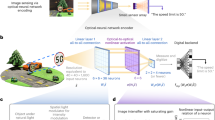Abstract
In this paper we propose a neural-network-based approach to solving optical symbol recognition problems, from node head recognition to handwritten digit recognition. We demonstrated that node heads could be easily recognized by using a set of fuzzy rules extracted from the parameters of trained neural networks. For handwritten digit recognition we demonstrated that only 12 features are sufficient to achieve a high recognition rate. Several databases were tested to demonstrate the effectiveness and efficiency of the proposed recognition method.
Similar content being viewed by others
Explore related subjects
Discover the latest articles, news and stories from top researchers in related subjects.References
Pruslin, D. H.: Automatic recognition of sheet music, SCD Dissertation. MIT, 1967.
Kassler, M.: An Essay toward the Specification of a Music-reading Machine, 1970, pp. 151–175.
Kassler, M.: Optical character-recognition of printed music: a review of two dissertations, Perspectives of New Music 11(2) (1972), 250–254.
Matsushima, T. et al.: Automated recognition system for musical Score, Bulletin of Science and Engineering Research Laboratory, Waseda University, No. 112, 1958, pp. 25–52.
Perau, D. S.: DO-RE-MI: a program that recognizes music notation, Computers and the Humanities 9 (1975), 25–29.
Tojo, A. and Aoyama, H.: Automatic recognition of music score, Proc. 6th International Conference on Pattern Recognition, 1982, p. 1223.
Sicard, E.: A efficient method for the recognition of printed music, 11th IAPR Int. Conference on Pattern Recognition, 1992, pp. 573–576.
Armand, J.-P.:Musical score recognition: a hierarchical and recursive approach, 2nd Int. Conference on Document Analysis and Recognition, 1993, pp. 906–909.
Wong Yip-San and Choi Andrew: A two-level model-based object recognition technique, Int. Sym. On Speech, Image Processing and Neural Networks, 1994, pp. 319–322.
Poulain, V., d'Andecy, Camillerapp, J. and Leplumey, I.: Kalman filtering for segment detection: application to music scores analysis, 12 IAPR Int. Conference on Pattern Recognition, 1 994, pp. 301–305.
Ng, K. C., Boyle, R D and Cooper, D.: Low-and high-level approaches to optical music score recognition, IEE Colloquium on Document Image Processing and Multimedia Environments, 1995, pp. 311–316.
Baumann, S.: A simplified attributed graph grammar for high-level music recognition, Proceeding the Third Int. Conference on Document Analysis and Recognition 2 (1995), 1080–1083.
Couasnon, B. and Camillerapp, J.: A way to separate knowledge from program in structured document analysis: application to optical music recognition, 3rd Int. Conference on Document Analysis and Recognition, 1995, pp. 1092 1097.
Todd Reed, K. and Parker, J. R.: Automatic computer recognition of printed music, Int. Conference Pattern Recognition, 1996, pp. 803–807.
Binbridge, D. and Bell, T. C.: Dealing with superimposed objects in optical music recognition, Sixth Int. Conference on Image Processing and its Application, 1997, pp. 756–760.
Blostein, D. and Baird, H.: A critical survey of music image analysis, In: H. S. Baird, H. Bunke, K. Yamanoto (eds), Structured Document Image Analysis, Springer-Verlag, 1992, pp. 405–434.
Newell, C.: MidiScan, Product information, Musitek, 1993.
Selfridge-Field, E.: Optical recognition of musical notation: A survey of current work, in Computing in Musicology 9 (1994), 109–145.
Kato, H. and Inokuchi, S.: A recognition system for printed piano music using musical knowledge and constraint, in Structured Document Image Analysis, H. Baird, H. Bunke and K. Yamamoto, (eds), Springer-Verlag, 1992, pp. 435–455.
Miyao, H. and Nakano, Y.: Head and stem extraction from printed music score using a neural network approach, 1995, pp. 1074–1079.
Yoda, I., Yamamoto, K. and Yamada, H.: Automatic construction of recognition procedures for musical nodes by GA, Proc. of DAS 94, 1994, pp. 203–209.
Shridhar, M. and Badreldin, A.: Recognition of isolated and simply connected handwritten numerals, Pattern Recognition 19(1) (1986), 1–12.
Suen, C. Y.: The role of multi-directional loci and clustering in reliable recognition of characters, in Proc. 6th Int. Conf. Pattern Recog, 1982, pp. 1020–1022.
Ali, F. and Pavlidis, T.: Syntactic recognition of handwritten numerals, IEEE Trans. Syst. Man Cybern. 7 (1977), 537–541.
Baptista, G. and Kulkarni, K. M.: A high accuracy algorithm for recognition of handwritten numerals, Pattern Recognition 21(4) (1988), 287–291.
Suen, C. Y., Nadal, C., Legault, R., Mai, T. A. and Lam L.: Computer recognition of unconstrained handwritten numerals, Proc. IEEE 80 (1992), 1162–1180.
Garris, M. D., Wilson, C. L. and Blue, J. L.: Neural network-based systems for handprint OCR applications, IEEE trans. on image processing 7(8) (1998), 1097–1112.
Chi, Z. and Yan H.: ID3-derived fuzzy rules and optimized defuzzification for handwritten numeral recognition, IEEE Trans. On Fuzzy System 4(1) (1996), 24–31.
Trier, O. D., Jain, A. K. and Taxt, T.: Feature extraction methods for characters recognition: A survey, Pattern Recognition 29 (1996), 64–662.
Su, M. C.: Use of Neural Networks as Medical Diagnosis Expert Systems, Computers in Biology and Medicine 24(6) (1994), 419–429.
Su, M. C., Hsieh, C. T. and Chin, C. C.: A Neuro-Fuzzy Approach to Speech Recognition without Time Alignment, Fuzzy Sets and Systems 98(1) (1998), 33–41.
Su, M. C., C. Liu,-W. and Tsay, S.-S.: Neural-network-based Fuzzy Model and its Application to Transient Stability Prediction in Power Systems, IEEE Trans. on Systems Man and Cybernetics 29(1) (1999), 149–157.
Lee, S.-W. and Pavlidis, T.: Nonlinear shape normalization methods for the recognition of large-set handwritten characters, Pattern Recognition 27(7) (1994), 895–902.
Gonzalez, R. C. and Wood, R. E.: Digital Image Processing, Addison-Wesley Publishing Company, Chapter 8, 1989.
Author information
Authors and Affiliations
Rights and permissions
About this article
Cite this article
Su, MC., Chen, HH. & Cheng, WC. A Neural-Network-Based Approach to Optical Symbol Recognition. Neural Processing Letters 15, 117–135 (2002). https://doi.org/10.1023/A:1015288717988
Issue Date:
DOI: https://doi.org/10.1023/A:1015288717988




